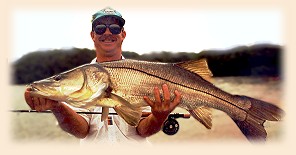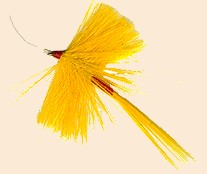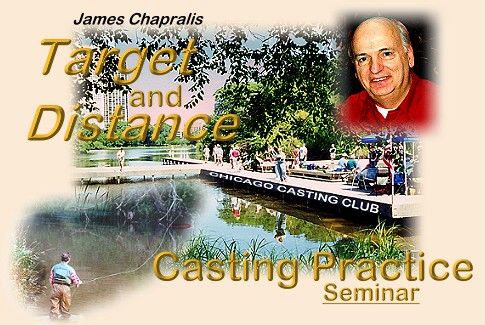|
In order to enjoy better fishing results, it is necessary
for most anglers to practice casting on a continuing basis. Admittedly,
practice is b-o-r-i-n-g, so it's my job to make casting practice so
much fun that you'll almost like it as much as fishing! And down the
road you might even want to enter a casting tournament! And Win!
LESSON TWO:
To review: To succeed in fly fishing, we need to become good
casters primarily in terms of accuracy, but also, under certain
circumstances, in distance. In our introductory remarks last week,
we mentioned that most of us learn the fundamentals of casting
through books or videos, casting schools, or, perhaps, from a
veteran fly-casting friend. But between fishing trips, these
lessons are lost, so it is necessary to practice our casting
periodically. We agreed that usually practice isn't fun. Well,
if you bear with me, we're going to make casting practice "fun,"
to a point that many of you will actually look forward to it.
We'll get to the juicy stuff - the casting practice fun things - next
week, but we need to go over some "ground rules" and set up some
targets. If you haven't read the first installment,
please read it now. To succeed, you must understand and accept the premise: good
casting is fun in itself, but also produces better fishing results.

Snook are very difficult to fool. They "chill out" next
to mangroves and often won't hit a fly or popper unless
it's within inches of the mangrove. This is where your
casting practice will give you an advantage.
WHERE DO WE PRACTICE? That's the advantage of "tournament"
or "practice" casting. We can do it anywhere. If you have a back
yard, say about 80 to 100 feet of cleared space, you can do it
there. Or maybe at a nearby park. Or at a football or a soccer
field. Better yet, perhaps there's a pond or you have a swimming
pool, because it's best to cast on water. If you live in the
northern climes, a gymnasium is a wonderful place in the wintertime
to sharpen your casting skills while waiting for spring.
All you need is some open area, where you can set up some targets
from 20 to 50 feet for most practice games. Remember, you're going
to need almost the same amount of room behind you for the back casts.
I prefer an open park or athletic field, because in addition to
the ample room, there is usually a breeze, and one of the facts of
angling life is that there is usually some wind on the waters which
can effect your casting. I sometimes practice in my back yard, which is not
very big, but mostly I go to a park for the serious sessions, including
distance. If I have more time, I drive to our casting club in Chicago's
famous Lincoln Park.
WHAT KIND OF TACKLE? You can use nearly any fly-fishing gear
you have. Assuming that most of you are trout fishers, an 8-ft. for
a No. 5 or 6 line is fine but an 8-1/2 ft. fly rod is better for some
events we're going to practice. If you're a bass-bug fly rodder,
you're probably using a 8-1/2 or 9-foot fly rod, that takes an 8
or 9 weight line.
 Whenever you practice your casting, tie on a piece of wool or a fly
(be sure to remove the barb and point to avoid an accident). Best
bet: Tie some flies like this sample. It's easier to see this
pattern and it's the one used in the casting tournaments.
I'm going to assume that your fly reel is spooled with the right
weight line for the rod you're using. Tie on a 7-1/2 ft. tapered
leader, perhaps tapered down to 2X or 3X for initial practice
sessions for the trout fishing events (you'll need a heavier
leader for Bass Bug practice event which we'll describe in a
later session). Now comes an important part. Whenever you are
practicing casting, always, repeat always; tie on a fly or a
piece of wool. (Of course, you must remove the point and barb
if you are using a fly, just in case you make a bad cast). Many
anglers practice without a fly or piece of wool. This is wrong
because a fly is to a line and leader what a tail is to a kite.
It stabilizes the cast. Without it, your leader swishes back
and forth and you change your casting stroke to accommodate
this. A piece of wool yarn, about the size of a No. 10 fly
(bright orange or yellow so that you can see it) is ideal.
Another thing: In practice or actual fishing always wear
eyeglasses (sun glasses or plain). Make that a "must" rule
whenever you are fishing or practicing. More than one person has
lost his vision because he was fly fishing without glasses.
Whenever you practice your casting, tie on a piece of wool or a fly
(be sure to remove the barb and point to avoid an accident). Best
bet: Tie some flies like this sample. It's easier to see this
pattern and it's the one used in the casting tournaments.
I'm going to assume that your fly reel is spooled with the right
weight line for the rod you're using. Tie on a 7-1/2 ft. tapered
leader, perhaps tapered down to 2X or 3X for initial practice
sessions for the trout fishing events (you'll need a heavier
leader for Bass Bug practice event which we'll describe in a
later session). Now comes an important part. Whenever you are
practicing casting, always, repeat always; tie on a fly or a
piece of wool. (Of course, you must remove the point and barb
if you are using a fly, just in case you make a bad cast). Many
anglers practice without a fly or piece of wool. This is wrong
because a fly is to a line and leader what a tail is to a kite.
It stabilizes the cast. Without it, your leader swishes back
and forth and you change your casting stroke to accommodate
this. A piece of wool yarn, about the size of a No. 10 fly
(bright orange or yellow so that you can see it) is ideal.
Another thing: In practice or actual fishing always wear
eyeglasses (sun glasses or plain). Make that a "must" rule
whenever you are fishing or practicing. More than one person has
lost his vision because he was fly fishing without glasses.
THE TARGETS: When we were kids first we wanted to learn
how to throw a ball, rock, stick or snowball, and after we
acquired the throwing motion, we wanted to hit a target. We
threw at objects. A garbage can. A tree. Whatever. And, boy,
did we feel good when we hit our target! Right?
The same applies with casting. After we develop a casting stroke,
and are comfortable with it, we need targets. Brightly colored
Hula Hoops make wonderful targets on the ground. I bought six
for $14.87 (and I think that the price even included an ice
cream bar).
If you can't find Hula Hoops you can make your own targets from
a variety of materials. An old brightly-colored rubber hose is
ideal. What you want to do is make six hoops that are about 30
inches in diameter. Use duct tape to secure the ends together.
Actually you need only five for most games but six for the Bass
Bug Event. If you are going to cast on water, you need some
small weights and string to anchor the targets, and some pieces
of wood or cork or other buoyant material to keep them afloat.
The "close" target will be about 20 to 25 feet away and the long
target will be 45 to 50 feet out.
Get those targets ready because next session we start with one
of the most important games.
Stay tuned every week.
~ Jim C. Chapralis
Next session: The Dry Fly Event.
About Jim:
Jim Chapralis is a world traveler, a pioneer in the international fishing
travel business, and author, most recently of Fishing Passion, reviewed in
our Book Review section. He is an avid angler - and caster.
Currently involved with the 94th Annual National Casting
Tournament July 29 to August 3, 2002. You can reach Jim via his
website www.AnglingMatters.com
|


 Whenever you practice your casting, tie on a piece of wool or a fly
(be sure to remove the barb and point to avoid an accident). Best
bet: Tie some flies like this sample. It's easier to see this
pattern and it's the one used in the casting tournaments.
Whenever you practice your casting, tie on a piece of wool or a fly
(be sure to remove the barb and point to avoid an accident). Best
bet: Tie some flies like this sample. It's easier to see this
pattern and it's the one used in the casting tournaments.
